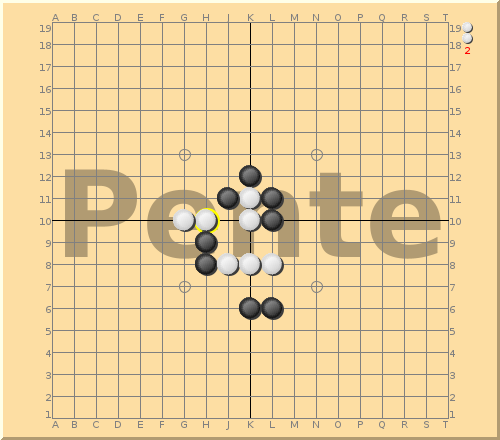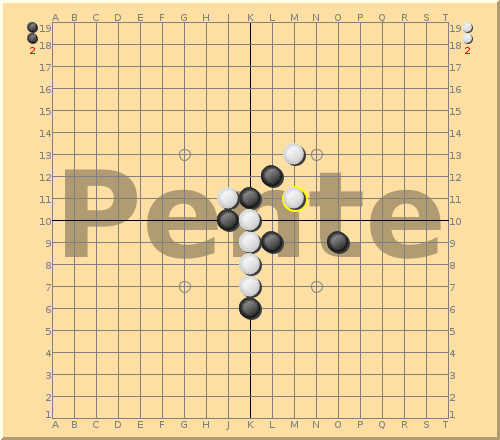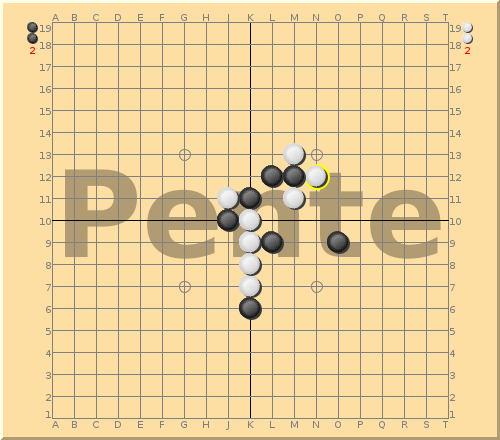Event "IYT July Fast Tournament 2"
GameType "Pente"
Site "itsyourturn.com"
Date "2001.07"
Round "1"
White "Oleg Stepanov"
Black "Carlos Ortiz"
Result "1-0"
Comment "Annotated by Oleg Stepanov. Edited by Walter Sandsquish. The unedited commentary can be seen on Oleg Stepanov's Pente Page."
1. K10 J11
2. G10 L10
3. K8 L11
4. K7 ...
Comment "This is a standard opening and we played it quickly. Some time ago people liked to play 4. ... K11, and this made for a lot of interesting games. My opponent played the more currently-popular move 4. ... K6 instead."
... K6
5. J8 ...
Comment "At first glance, 5. ... K9* looks good for Carlos because he would capture a pair, but 6. M11* would capture a pair for me and leave Black's stones scattered. White would have four stones to build from while Black would only have two. My opponent chose not to eat the stones immediately, a sign of a strong player."
... H9
6. L8 L6*
Comment "7. K11 is the best response here. I could have played 7. J6 and then 8. K11, but I like to try to surprise my opponents ..."
7. K11 K12
Comment "At first glance, 7. ... K9 looks good, but it would have been met with 8. J8 (surprise!), which would threaten to capture."
8. J8 H8
9. H10 ...

K10,J11,G10,L10,K8,L11,K7,K6,J8,H9,L8,L6,K11,K12,J8,H8,H10
Comment "8. J8 and 9. H10 are standard practice: force your opponent to make a pair and then attack it. But, here, it's part of a larger plan. If 9. ... H7, then White could make a four with 10. K9, and Black's forced response would allow me to make multiple captures. This wouldn't have been possible if I hadn't played 7. K11. 9. ... L12 to save the other threatened pair won't help either. I could then threaten to make fours with M8, H6, K9, and F10. So, Carlos' next move must be to K9."
... K9*
10. F10 ...
Comment "10. F10 is critical. Why? Black is up by two captures and is threatening 10. ... H7, which would take the tempo. (White would be forced to block a potential three-by-four.) The only way to keep the tempo is to attack. If 10. J9, then 10. ... J7. See the problem? But, 10. F10 will work."
... E10
11. J9 G11
12. J10 K10
Comment "Because my opponent must keep this four closed, I can keep making captures."
13. M10* K10
14. M12* K10
15. J7
Comment "Black resigns."
1-0
Event "IYT July Fast Tournament 2"
GameType "Pente"
Site "itsyourturn.com"
Date "2001.07"
Round "1"
White "Carlos Ortiz"
Black "Oleg Stepanov"
Result "0-1"
Comment "Annotated by Oleg Stepanov. Edited by Walter Sandsquish. The unedited commentary can be seen on Oleg Stepanov's Pente Page."
1. K10 L11
2. N10 J10
3. K8 L9
Comment "The Stepanov Opening."
4. K9 K11
5. M11 L12
Comment "These are all standard moves for this opening."
6. K7 K6
7. J11* ...
Comment "Pente is a fast game that is usually won by the player who mounts the first attack. However, White is overly aggressive here. Should I answer with an equally aggressive move and capture a White pair with 7. ... H12? Of course not. It would only set up more attacks by White."
... K11
8. M13 ...
Comment "I don't think 8. M13 is as strong a move as the more usual 8. H9. This move also seems inconsistent with White extending his three downward earlier with 6. K7. However, if my opponent wants to attack the upper part of the formation, I can frustrate his ambitions with 8. O9* 9. M11, which would eat a White pair and leave another pair in atari."
... O9*
9. M11 ...

K10,L11,N10,J10,K8,L9,K9,K11,M11,L12,K7,K6,J11,K11,M13,O9,M11
Comment "My previous move was simple, but it resulted in a complex position. If 9. ... H12*, then I would lose if White creates an open three with 10. M12 M10 11. N11* and an unbeatable position. Maybe 9. ... L10? It looks good. A naive opponent might answer with 10. L11 N11*. But a savvy player would respond with 10. M9! making a stretch three, putting part of my three-by-three in atari, and creating the potential for many more attacks. Perhaps 9. ... L11? No, making a three that your opponent can block with his own three is a losing move. Apparently, the only move I have here is 9. ... M12."
... M12
10. N12 L10
Comment "This divides White's formation and makes a split three."
11. M9 O13*
Comment "White set himself up for a stretch three with 12. K12*, so I captured across it."
12. J12* K11
13. N12 ...

K10,L11,N10,J10,K8,L9,K9,K11,M11,L12,K7,K6,J11,K11,M13,O9,M11,M12,N12
Comment "White forced 12. ... K11 by opening one end of the four, and then attacked a pair of my stones, as a good player would. Perplexed, I thought about this position for a long time. Suppose I play 13. ... L10. White could capture my two stones in atari, then I could rebuild my split three with 14. ... L12. You've probably heard that you can't stop a three by making a three someplace else, but in this case, White could play 15. O11 and still have a strong position. So I chose to play 12. ... O11, not only because it gives me a stretch three, but also because it's a good place for White to play. Although I didn't see it at the time, computer analysis later showed that 14. ... N10 would also have been a winning position."
... O11
14. K12* L12
15. H12 ...
Comment "My opponent was afraid of me getting two captures in a row and saves the wrong pair. He was probably getting tired. My next move will force 16. M13, allowing me to play 16. ... L13, which will secure the win."
... L14*
16. M13 L13
17. F12 J13*
18. G12 J12
19. E12 D12
20. H13 L15
21. L10* L11
0-1
Message was edited by: sandsquish at Oct 8, 2014 2:42 AM
|